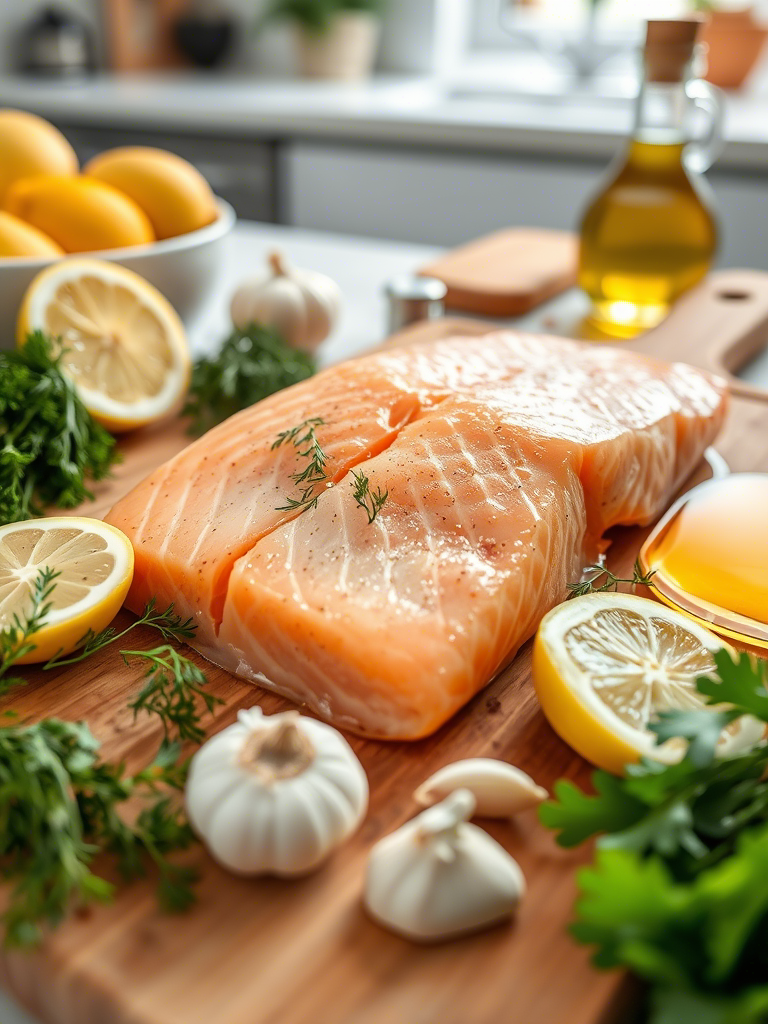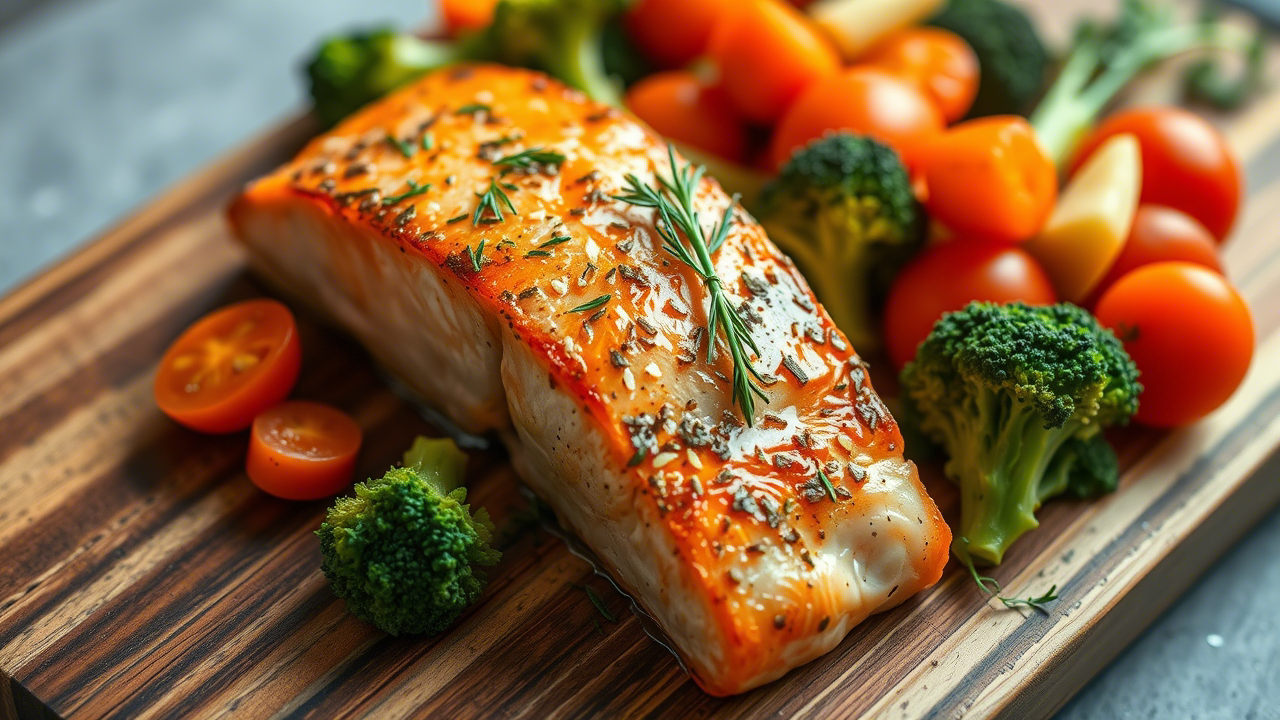Best Healthy Salmon Recipe
The kitchen is my wellness sanctuary. It’s where nutrition and deliciousness come together. Salmon is more than food; it’s a heart-healthy protein that makes cooking a self-care act.
Finding the best Healthy salmon recipe is more than just following steps. It’s about knowing how each ingredient boosts your health. Salmon’s nutritional profile can take your diet from good to great.
In this guide, you’ll learn how to make a salmon dish that’s both tasty and nutritious. These tips are for everyone, whether you’re busy or love cooking at home. They’ll help you make meals that are good for you and delicious.
Table of Contents
Key Takeaways
- Salmon provides exceptional omega-3 fatty acids
- Nutrient-dense meals support overall health
- Easy cooking techniques make healthy eating accessible
- Heart-healthy proteins can be delicious and simple to prepare
- Fresh ingredients are key to an outstanding salmon recipe
Understanding Different Types of Salmon for Your Recipe
Choosing the right salmon can make a big difference in your cooking. Wild-caught salmon tastes better and is healthier than farm-raised. Each type of salmon adds something special to your meal, making it a great choice for a healthy diet.

Wild-Caught vs Farm-Raised Salmon
It’s important to know the difference between wild-caught and farm-raised salmon. Wild-caught salmon is leaner and has more omega-3 fatty acids. It tastes better and has a more complex flavor than farm-raised salmon.
- Wild-caught salmon contains higher levels of natural nutrients
- Farm-raised salmon may have more consistent availability
- Wild salmon typically has less environmental impact
Popular Salmon Varieties: Sockeye, King, and Coho
The Pacific Northwest is home to three favorite salmon types. King salmon has a rich, buttery taste and lots of omega-3s. Sockeye has a deep red color and strong flavor. Coho is milder and perfect for those who like subtle tastes.
How to Choose Fresh Salmon at the Store
Choosing top-quality wild-caught salmon takes some skill. Look for bright, firm flesh and a clean smell. Here are some tips to pick the best salmon for your recipe:
- Clear, bright eyes
- Firm, elastic flesh
- No strong fishy odor
- Vibrant, uniform color
By learning about different salmon types and how to pick them, you’ll improve your cooking. You’ll also get to enjoy the amazing health benefits of this incredible fish.
Essential Ingredients and Equipment for Healthy Salmon Recipe
Starting with the right ingredients and tools is key to making tasty low-calorie recipes. Having a well-stocked kitchen makes meal prep easy.
For a healthy salmon dish, you’ll need these ingredients:
- Fresh salmon fillet
- Extra virgin olive oil
- Fresh lemon
- Garlic cloves
- Fresh herbs (dill, parsley, or thyme)
- Sea salt
- Cracked black pepper
Also, you’ll need the right kitchen tools for a perfect salmon dish:
- Non-stick baking sheet
- Aluminum foil
- Silicone pastry brush
- Sharp chef’s knife
- Instant-read meat thermometer
Using high-quality, fresh ingredients is crucial for your recipes. Choose wild-caught salmon when possible for better nutrition and taste.
| Ingredient | Calories per Serving | Nutritional Benefit |
|---|---|---|
| Wild Salmon | 206 | High in Omega-3 fatty acids |
| Olive Oil | 119 | Heart-healthy monounsaturated fats |
| Lemon | 17 | Vitamin C and antioxidants |
Meal prep is easy with these ingredients and tools. Prepare your salmon recipe ahead by chopping herbs and measuring seasonings. Have your baking sheet ready with foil.
Step-by-Step Cooking Instructions
Cooking salmon to perfection needs precision and care. Whether you’re baking or grilling salmon, knowing the right techniques makes a big difference. It can turn your dish from good to great.
Preparing the Salmon
Begin by picking a high-quality salmon fillet. Pat the fish dry with paper towels for a crisp exterior. Season it well with:
- Sea salt
- Freshly ground black pepper
- Olive oil
- Fresh herbs like dill or parsley
Perfect Temperature and Timing Guide
Getting the right temperature is key for delicious baked or grilled salmon. Here’s a guide to help you:
| Cooking Method | Temperature | Cooking Time | Doneness |
|---|---|---|---|
| Oven Baking | 375°F | 10-15 minutes | Medium-rare (115-125°F) |
| Grilling | 400°F | 8-12 minutes | Medium (125-140°F) |
Testing for Doneness
There are two ways to check if your salmon is ready:
- Thermometer Method: Insert a meat thermometer into the thickest part of the fillet
- Fork Test: Gently press with a fork – the fish should flake easily and appear opaque
Pro tip: Let your salmon rest for 3-5 minutes after cooking. This helps lock in juices and enhance flavor.
Flavorful and Healthy Side Dish Pairings
Make your salmon dinner even better with tasty side dishes. These can turn a simple meal into a feast that’s good for you. The right sides can make your salmon dish a hit with both your taste and health.
Roasted veggies are a great match for salmon. Here are some easy side dish ideas:
- Asparagus with garlic and olive oil
- Roasted cherry tomatoes with fresh herbs
- Crispy Brussels sprouts with sea salt
A tangy lemon dill sauce is key to a great salmon meal. It adds flavor without many calories. Here’s a simple recipe:
- 1/2 cup Greek yogurt
- 2 tablespoons fresh dill, chopped
- Zest of one lemon
- Salt and pepper to taste
Pair your salmon with a colorful veggie mix and lemon dill sauce. This way, you get a balanced, nutrient-dense meal that’s also yummy and healthy.
Conclusion
Learning to cook salmon makes your kitchen a health hub. You’ve picked top-notch salmon and learned how to cook it. This opens up a world of Heart-healthy proteins that boost your meals.
Meal prep ideas make adding salmon to your diet easy and fun. Try cooking salmon fillets at the beginning of the week. Then, you can whip up salads, grain bowls, and more. Salmon’s flexibility keeps your meals interesting.
Your salmon journey is just starting. Keep trying new cooking methods and flavors. Each salmon dish you make is a step towards better health. It brings omega-3s that are good for your heart and reduce inflammation.
Now, you’re ready to make salmon a key part of your diet. Dive into the world of cooking and enjoy the health perks of this amazing fish.
FAQ
What’s the difference between wild-caught and farm-raised salmon?
Wild-caught salmon comes from the ocean and tastes richer and has more omega-3s. Farm-raised salmon is raised in controlled places, affecting its taste and nutrition. Wild-caught salmon is often better for the planet and your health, but it costs more.
How do I know when salmon is fully cooked?
Check salmon’s doneness with a thermometer (145°F) or the fork test. Cooked salmon flakes easily and looks opaque with a pink color. It should be moist but not raw.
What are the best cooking methods for salmon?
Salmon can be cooked many ways, like baking, grilling, broiling, or pan-searing. Baking and grilling keep it moist and flavorful. Each method has its own benefits, like baking’s even heat and grilling’s smoky taste.
How often should I eat salmon for optimal health benefits?
Eating fatty fish like salmon twice a week is good for your heart. It reduces inflammation, boosts brain function, and supports heart health. Always talk to a doctor about what’s best for you.
What are the best seasonings for salmon?
Use fresh dill, lemon zest, garlic, black pepper, and sea salt for salmon. Try thyme or rosemary for deeper flavors. Olive oil, honey, and Dijon mustard make tasty marinades without extra calories.
Can I meal prep salmon in advance?
Yes, salmon is great for meal prep. Cook it ahead and store it in the fridge for 3-4 days. Reheat it gently to keep it moist. Cooking it slightly under can help.
What are the most nutritious salmon varieties?
Sockeye, king, and coho salmon are very nutritious. Sockeye has the most omega-3s, while king has a rich flavor. Coho is leaner with a milder taste. Each variety adds unique benefits to a healthy diet.
How can I ensure my salmon is sustainably sourced?
Look for MSC or ASC certifications for sustainable salmon. These labels mean the fish was caught or farmed responsibly. Check seafood guides from places like the Monterey Bay Aquarium for eco-friendly choices.

